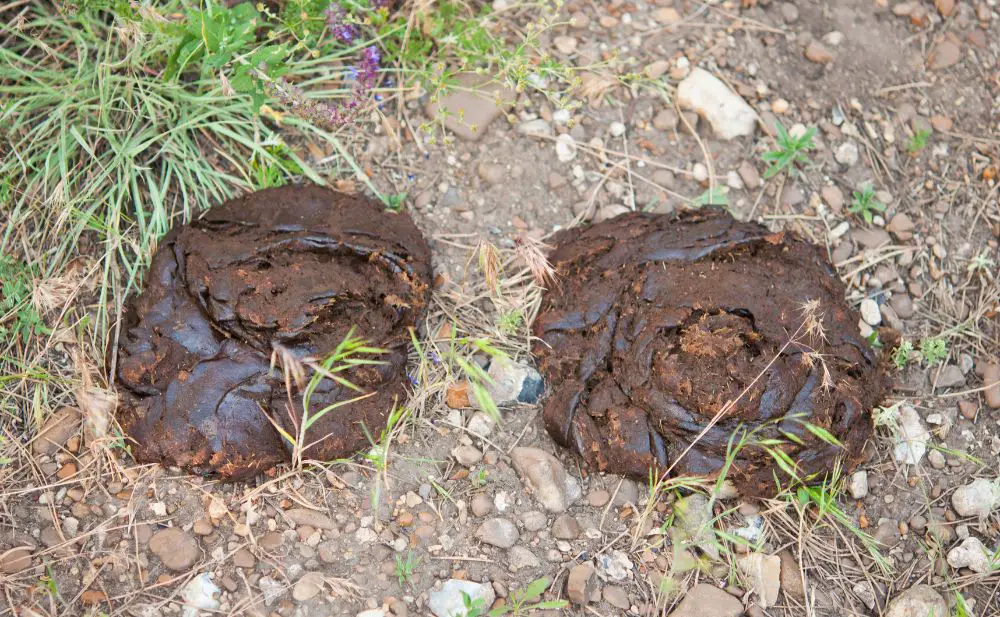Visual cow dung assessments can give you an accurate idea of your cattle’s rumen health and how well they are coping with their diet, plus valuable early indication digestion or hydration problems.
These problems might include:
- Too much or too little soluble or degradable protein.
- There may be an excess of minerals and extremes of fiber and starch.
- Issues with a T.M.R. or total mixed ration.
- Evidence of mycotoxins in feed.
- A general miscalculation in feed composition and quantities.
While very visually unappealing, it’s worth taking a few minutes out of every week to complete these inspections.
Table of Contents
How Does Cow Poop Vary in Appearance?
Cow feces vary in color, shape, and texture.
| Healthy cow | Poo from a healthy cow resembles a thick cake batter and is moist enough to spread and form a small pile. The excrement is pie-shaped with a slightly higher middle section. It is usually a light to mid-brown color. |
| Green manure | Green manure can occur and suggests that the cow has only been eating green grass. A browner stool indicates the presence of a mainly grain-based diet. |
| Thinner feces | Thinner feces with a gray to dark brown color are relatively common and result from the kind of grain in their diet. |

The circular shape of fresh cow dung has given rise to several nicknames like cow pats, cow pancakes, or cow pies.
How Cow Poop Highlights Health Issues
1. Consistency
As we’ve mentioned, a semi-liquid custard-like consistency that stands about two inches is ideal. The poop forms concentric rings and is moderately sticky. This consistency is preferred for lactating cows, indicating good rumen health and an adequately digested ration.
If the manure is thicker but still features concentric rings, this combination could signify a ration imbalance, especially in a lactating cow. You may have to raise the soluble or degradable protein levels in the cow’s ration or reduce the levels of fiber. However, this thicker consistency would be ideal for pregnant heifers or dry cows.
If the manure is excreted as dryish balls, dehydration is almost certainly the reason. There could also be a ration imbalance.
2. Hindgut Irritation or Ruminal Acidosis
If the poo is not thick to sustain itself in a pile (being mainly liquid and forms shallow puddles) could mean your cow has an illness like hindgut irritation or ruminal acidosis.
If the poop is still thick enough to form a pile but only stands about an inch high, this could also indicate an illness. Nevertheless, this kind of stool is common in cows that are fresh or are about to freshen, which is where they start producing milk after becoming pregnant.
It could also result from an over-rich diet, resolved by switching the cow to a higher-fiber diet with more grass and hay than grain.
When conducting a technical assessment of manure produced by your herd of cows, 95 percent of your cattle should fall into the same category. If the figure is less, your cows may be sorting their T.M.R. or eating spoiled feed.
3. Undigestable Content
Problems with your cow’s digestion or rumination might be evident by undigested forage or grain in the manure. You might also notice bubbles or foam and mucin casings.
It’s crucial to review your cow’s roughage intake when you notice abnormal excrement. Digestion problems might arise if their feed contains too much lignin and stools stack higher than expected.
Common Uses of Cow Poop On The Farm
When the compost is ready, you can use it to feed compost worms. The worms will add their castings to the compost, creating an even more productive bio-available environment for your plants. Composted cow poop makes an excellent growing environment for garden plants, either for the soil, under the mulch or use it as a top dressing.
Some dairy farmers (particularly more extensive operations) have anaerobic digesters which turn cow dung into electricity via biogas which can power a farm generator. However, the returns on converting manure into electricity are low. Many California farmers take advantage of the state’s low-carbon fuel standards program and use the digesters to make renewable natural gas instead.
